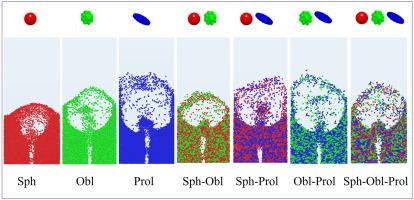喷淋床内非单分散颗粒体系流化的CFD-DEM研究
IF 4.3
2区 材料科学
Q2 ENGINEERING, CHEMICAL
引用次数: 0
摘要
喷淋床是一种流化床,因其优良的传质和传热效率而广泛应用于各种工业生产过程。在实际应用中,含有非球形颗粒的多组分颗粒系统的流化在喷淋床中经常遇到。因此,为了更好地理解多组分颗粒系统的喷射行为,本研究采用CFD-DEM(计算流体动力学-离散元法)耦合方法来研究多组分颗粒系统的喷射行为。本文包括球形粒子和两种椭球粒子(即扁圆椭球和长条形椭球)。通过这三种颗粒类型的组合,模拟了七种不同的体系(三种单分散体系、三种二元混合物和一种三元混合物),分析了颗粒形状和颗粒体系组成对喷射行为的影响。模拟结果表明,在含有球形或扁圆形椭球粒子的体系中引入非球形粒子有利于增强喷涌行为,而在椭球粒子体系中加入球形粒子则有利于抑制喷涌行为。在球形颗粒体系中加入非球形颗粒可以增强颗粒的互锁性,而使用扁形颗粒的影响比使用长条形颗粒的影响更大。此外,颗粒形状对喷口偏转行为的影响相当复杂,使用长形椭球颗粒与使用扁形椭球颗粒可能产生相反的效果。这些发现将为优化涉及复杂颗粒混合物的喷淋床操作提供有价值的见解。本文章由计算机程序翻译,如有差异,请以英文原文为准。

CFD-DEM investigation of fluidization of the non-monodisperse particle system in a spouted bed
Spouted bed is a type of fluidized bed that has been widely used in various industrial processes because of its excellent mass and heat transfer efficiency. In practical applications, the fluidization of the multicomponent particle system containing non-spherical particles is frequently encountered in spouted beds. To better understand the spouting behaviors of the multicomponent particle system, therefore, this study employs a CFD-DEM (Computational Fluid Dynamics-Discrete Element Method) coupling approach to investigate the spouting behaviors. Spherical particles along with two types of ellipsoidal particles (i.e., oblate ellipsoid, and prolate ellipsoid) are included in this paper. Through the combination of these three particle types, seven distinct systems (three monodisperse systems, three binary mixtures, and one ternary mixture) are simulated to analyze the effects of particle shape and composition of particle systems on spouting behaviors. The simulation results reveal that introducing non-spherical particles into systems containing either spherical or oblate ellipsoidal particles tends to enhance spouting behaviors, whereas adding spherical particles to prolate ellipsoidal particle systems inclines to suppress it. The addition of non-spherical particles into the spherical particle system can enhance the particle interlocks, and using the oblate particles should have more important influence than prolate particles. Moreover, the influence of particle shape on the spout deflection behaviors is quite complicated, and the use of prolate ellipsoidal particles versus oblate ellipsoidal particles may produce opposite effects. These findings should provide valuable insights for optimizing spouted bed operations involving complex particle mixtures.
求助全文
通过发布文献求助,成功后即可免费获取论文全文。
去求助
来源期刊

Particuology
工程技术-材料科学:综合
CiteScore
6.70
自引率
2.90%
发文量
1730
审稿时长
32 days
期刊介绍:
The word ‘particuology’ was coined to parallel the discipline for the science and technology of particles.
Particuology is an interdisciplinary journal that publishes frontier research articles and critical reviews on the discovery, formulation and engineering of particulate materials, processes and systems. It especially welcomes contributions utilising advanced theoretical, modelling and measurement methods to enable the discovery and creation of new particulate materials, and the manufacturing of functional particulate-based products, such as sensors.
Papers are handled by Thematic Editors who oversee contributions from specific subject fields. These fields are classified into: Particle Synthesis and Modification; Particle Characterization and Measurement; Granular Systems and Bulk Solids Technology; Fluidization and Particle-Fluid Systems; Aerosols; and Applications of Particle Technology.
Key topics concerning the creation and processing of particulates include:
-Modelling and simulation of particle formation, collective behaviour of particles and systems for particle production over a broad spectrum of length scales
-Mining of experimental data for particle synthesis and surface properties to facilitate the creation of new materials and processes
-Particle design and preparation including controlled response and sensing functionalities in formation, delivery systems and biological systems, etc.
-Experimental and computational methods for visualization and analysis of particulate system.
These topics are broadly relevant to the production of materials, pharmaceuticals and food, and to the conversion of energy resources to fuels and protection of the environment.
 求助内容:
求助内容: 应助结果提醒方式:
应助结果提醒方式:


